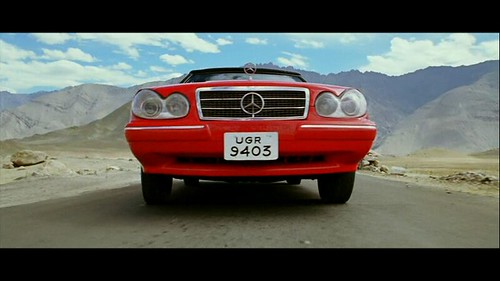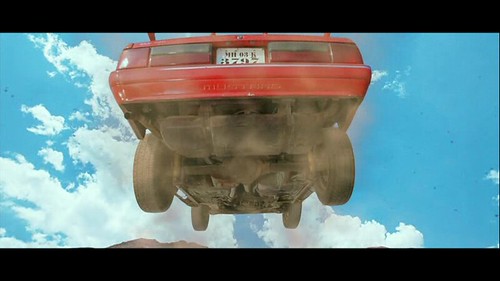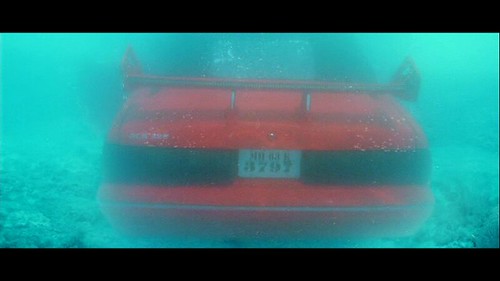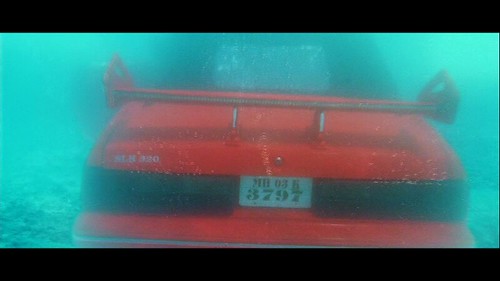Friday, September 18, 2009
she's the man
Wednesday, September 16, 2009
the third rogue
The soundtrack's not as rewarding as the promos. There's the promo that boasts some great voiceovers over what is otherwise a standard issue trailer showcasing a star, a pretty face, nauseatingly bland stylised action intercut with more nauseatingly bland stylised action and the obligatory dance sequences.
he walks casually
he talks casually
he eats casually
he loves casually
he kills casually
but (pronounced: buh -- rhymes with 'duh' -- T) he dances seriously
मुझे खुद को भी नहीं पता कि मैं कितना कमीना हूँ is the kind of line that would never have made it to Vishal Bhardwaj's film.
The second trailer's the official high-quality loud monster that features font styles that might fit well in video games and graphic novels (in fact, all the stills seem like they came from pages of some violent graphic novel). It opens with agonising an blinky-winky display of shots with ASLs that you would need a vernier calliper to measure. Lack of content tossed at you at the speed of constipated humming birds. The South Indian spelling bug takes over as you are told that it's a Prabhu Dheva film. That the action director is someone called Vijayan is quite obvious when you see goons spinning into the air on a semi-vertical axis after being punched. But the best is yet to come. You realise that the filmmakers have sprung a conceptual coup. This film is not merely a remake of a brain-dead actioner. It happens to be a showcase for Bollywood's version of a human transaction manager -- one that will leaving CICS, MTS and Tuxedo light years behind. It is all clear when you hear the last line on the trailer.
एक बार जो मैंने commitment कर दिया उसके बाद तो मैं खुद की भी नहीं सुनता
Monday, September 14, 2009
reel me this, reel me that
Waitress [October 01, 2008]: It's not hard to be reminded of Scorsese's film when watching Keri Russell in a fantastic performance as Jenna Hunterson. The film's trailer was an exceptionally good one (the kind that piques your interest in a film instead of being a showcase of the best bits of a piece of creative guano). It was only several months later that I settled down with the DVD in the player. The film confidently mixes the essence of a chick flick with a compassionate study of characters and humanity laced with broad strokes of whimsy and constant cheer. Unfortunately, the senseless murder of Adrienne Shelly has robbed us of a filmmaker who seemed poised to offer so much more.
what is dev benegal up to?
The man who helmed that fine cinematic adaptation of Upamanyu Chatterjee's English, August years ago and the under-sung darkly funny Split Wide Open has been struggling for years to get a DVD of the film out. Despite several posts that promised salvation and some that were quite depressing, a post appeared with a ray of hope. This, of course, comes amid posts dedicated to his new film Road, Movie (that comma seems like a tribute to the Madna movie) starring the ever-adventurous Abhay Deol. There's a teaser for those interested. Those lucky enough to be in attendance at the Toronto International Film Festival on September the 18th are even luckier.
[october 07, 2009]: Another trailer's up -- it's a montage of moments after we get the general idea that our protagonist is out to discover himself. I don't see anything extra being revealed; and I love that background score.
Saturday, September 12, 2009
the successful tamperer
There are hints of foul play in the taglines on the cover: a rare treasure ... 15 unreleased songs revived and digitally mastered in 2009. The word revived when Sanjeev Kohli is nearby can mean only one thing. More evidence comes from two places.
The first is this bit of text below the track list:
all songs composed and recorded by madan mohan during his lifetime
these songs were from shelved films between 1964 and 1972
instruments added in 2009 to enhance the quality of old recordings
The second is the credit for additional musicians in the inlay sheets (Incidentally, technical supervisor Victor Dantes was a comrade-in-arms in a similar successful experiment called the "Legends" series).
This is what happens when you have people with insufficient technical chops to pull off a remastering job. One must also credit the purchasing majority that doesn't really care.
An interview with Sanjeev Kohli posted over at PFC contained some revelatory comments from the man himself. Here is what was said on the subject of the reverbs and other confetti added to the tracks:
I have one serious complaint against the ‘Legends’ series of music compilations. I feel that by adding reverb, the digitized songs on these CDs lost their rich depth of original vocals and acoustic orchestration. They sound hollow!
You are right in your observation. But the reverb effect was added to nullify the hiss and scratchy sounds of old records. That does muffle the sound a bit but the general public seemed to have liked the sound! Perhaps the connoisseurs might feel differently about it.
Earlier in the interview, Kohli talks about Tere Bagair (I have taken the liberty of emphasising the portions of interest for you, O patient reader)
Now the new album- 'Tere Bagair' (released by Yashraj Music) will present all the ten songs from 'Treasure Unrevealed' in full, extended versions and it will also have five more tracks originally recorded by Madan Mohan. This album will be a treat not only for the fans of Madan Mohan but also for the fans of singers like Lata, Asha, Rafi and Kishore because they will get an opportunity to experience many original Madan Mohan recordings in their favourite singer's voice. Moreover these songs were previously either unreleased or inaccessible. Even those listeners who had already heard 'Treasure revealed' would find many new things in 'Tere Bagair'. The recording quality of the album is excellent since the master tapes have been used to reproduce the songs. In some songs, I have re-recorded the tabla tracks and added some harp sounds but even that is done in such a way that it would perfectly fit in the sound of the 60s, when those songs were originally recorded.
You can't compare 'Tere Bagair' to 'Veer Zaara' because ' Tere Bagair' is an album of out and out Madan Mohan originals whereas in 'Veer Zaara', his tunes were modified to suit the times and also the film's requirements.
This, ladies and gentlemen, is a man of commerce talking.
stereotypes on the streets of Pune
There is a reason Pune roads are never going to get better no matter how many flyovers you build, no matter how many streets you convert to one-way traps, no matter how many regulations you prescribe on termite-eaten papers of law, no matter how much you try to subvert the laws of physics with the power of unenforced law. That reason, dear hapless smoke-ingesting, Brownian reader is the rich and variegated set of stereotypes of riders and commuters unleashed on the streets of Pune. This helpless spectator presents a few.
The Light Brigade: Even if Tennyson's poem loses its impact because people no longer cared about the Crimean war, it would survive thanks to finding another image in the real world –- this is the critical mass revving up near a traffic signal awaiting the change from red to green desperately like the incontinent in search of a ceramic throne. Even before the chromatic switch, a deluge of multimodal impatience sweeps the intersection and intersecting streets. It's the chariot race from Ben Hur duplicated across space and time.
Neo wannabes in the Metropolitan Matrix: You're familiar with the commuters who behave as if they had received an internal memo saying they were Neo Anderson and that they were the One. Assuming all surrounding traffic to represent the Matrix, these people waltz across crowded intersections (causing even graver deadlocks), shimmy through cracks between cars, along invisible tracks connecting the front wheel of a scooter to the rear wheel of a motorcycle making a game of snakes and ladders look like an exercise in drawing perfectly straight lines.
Friday, September 11, 2009
reel notes from long ago
Equilibrium [December 29, 2006]: This tale of dystopia chooses to be a thriller instead of exploring familiar ideas like the suppression of emotion using drugs (Brave New World's soma -- an idea seen in movies like THX 1138 -- becomes Prozium, a portmanteau of Prozac and Valium), the destruction of art (just books in Fahrenheit 451) and the totalitarian state that is constantly monitoring its people (1984). It chooses to be an action thriller and a showcase of Gun Kata. I liked Gun Kata and that's the sole reason I have to watch Ultraviolet some day. Christian Bale does no wrong with the character of John Preston both in the dramatic and the action sequences. Another William Butler Yeats poem makes it to the canon of sci-fi/apocalyptic films. Knowing about Tetragrammaton helps, as does finding out why that fight sequence in Aan: Men at Work looked so familiar.
Eye of the Needle [August 06, 2006]: This, as far as I can tell, is the only adaptation of a Ken Follett novel for the big screen. It also happens to be directed by Richard Marquand, who, thanks to this film, was chosen to direct Return of the Jedi, the most famous film in his ouevre. I had enjoyed reading the book years ago and still remembered the essential narrative elements when I finally got down to watch Donald Sutherland lead a strong cast in a competent well-paced cinematic adaptation. The camera angles and the editing seem representative of the 70s, even though the film was released in 1981. When Sutherland bumps into a motorcycle near a station building, I loved the cut to the sound of the bike as the camera follows the countryside he is riding through. I also noticed the not-so-uncommon technique of allowing scenes top open with sounds from the previous scene. Both elements are probably examples of "the hook" (see also: a lovely essay on this by David Bordwell). Oscar Wilde's The Happy Prince gets some great promotion here when Faber reads from it to little Jo. Miklós Rózsa's score, unfortunately, amplifies the attempt of the production to sound and feel very monumental; the dramatic appeal of the domestic conflict suffers as a consequence. A minimalist score exploring the various emotional textures of a few motifs might have been a better companion. Those familiar with either this film or Follett's source novel will have noted the unacknowledged debt Fanaa's second half owed to this film (with a few necessary alterations for the film to go down well with national lovers of such ingenuous cinema and nostalgic NRIs dying to throw their dollars at paeans to trite familial ideals and values). Ironically, a few years later, Marquand helmed another film, which served as carrion for the rapacious rodins of Bollywood -- the film was called Jagged Edge and we all know it well as Kasoor (in which Aftab Shivdasani became Jeff Bridges and Lisa Ray became Glenn Close).
Alag [August 05, 2006]: Powder is transmogrified into a Bollyversion seasoned with all the delicacies that make a Bollywood movie suck -- the Hindi/English nonsense mix (say it in English; now say it in Hindi; now mix 'em up), retrograde exposition (A scientist from California!) and irritating song breaks (apun kii Tolii deserves an award and a place in the Hall of Non Sequitur Shame). Plaudits must be reserved for the "story" credited to Tagore Almeida (lovely name that) and a "screenplay" churned out by Almeida and director Ashu Y. Trikha. The film tries to be a showcase for Akhay Kapoor's "talents" (he can dance! he can brood! but can he act?) and a breeding ground for bad subtitles (सिंह becomes "singh" and माहिया वे राँझना वे becomes "lover ... ranjhana! you are only my home!"). When the subtitles on the DVD got stuck, the people at the Indian store whence this VHS rip came from were kind enough to stop the DVD player and hit play again to fix the problem (the evidence was recorded for all you caring customers). It's also an exhibition of bad editing (like most Bollywood films) and a slavish adoption of technique without just cause (shoot me in bullet time!). It also had a hidden lure which drew a host of Bollywood A-listers to feature in a song at the end (this is your cheapest opportunity to see Shah Rukh Khan, Karan Johar, Abhishek Bachchan, Arjun Rampal, Bipasha Basu, Lara Dutta, Bobby Deol, Priyanka Chopra and Preity Zinta). But the film truly belongs to Tom Alter's bid for a Razzie for Worst Actor in a Foreign Film as Doctor Richard Dyer, the villain of the piece claiming to be a crusader against epilepsy, Parkinson's Disease, Alzheimer's and पागलपन. Watch him as he deliciously mouths inane phrases like "Human mind," proclaims himself "The greatest genius in the entire universe" and delivers pronouncements like "Emotion Revolution का दुश्मन है"). That, a decent opening title sequence and abuse of the Doom fireball sound make this film worth your while (barely). I leave you with a priceless piece of dialogue from the film:
tejas (akshay kapoor): क्या हम थोड़ी देर रुक सकते हैं?
purvaa (dia mirza): हाँ , sure, brake है न गाडी में
Thursday, September 10, 2009
what a big search box you have!
Tuesday, September 01, 2009
bollywood's chameleon car

The film opens with a red mercedes SLK 320 on the wild road accompanied by a stereo switching between a little ode to 80s rock ("She's a highway to hell" courtesy Ranjit Barot) and kabhii kabhii (the plaintive voice of the late Mukesh).

It's a red Mercedes SLK 320 with a spoiler. UGR 9403.
And then it veers out of control and drives off the road, to the side and over the edge. The landscape looks fake, the milestone flying by is bad CG. But the worst is yet to come. A montage of obviously fake VFX shots follows to illustrate the inevitable -- the descent of the car succumbing to gravity into the water below.

It's at this point that things become confusing. The car's licence plate goes into the witness protection programme in midair relocating, in a manner of registration, to the state of Maharashtra.

A fine shot of the automobile's derriere laced with dust is marred by the word embossed on the rear bumper. I'm confused -- when did Ford team up with Mercedes?
Several minutes later, we return to the car under water.

The licence plate continues to be the same as it was before the car hit the water. It is also clear that the car is an SLK 320; I can't see lower part of the bumper, so it's hard to see if the embossed Mustang is still there (I wish I had a better angle).

Peculiar. Very peculiar.
Since this is a film laced with references to other films (with, as a later blog post may reveal, the choice of films bears a strong bias for the Yash Raj canon) and especially recent YRF productions, it is possible to construe an explanation for this gaffe and credit it as being a little in-joke. Remember the Mustang fetish in Dhoom? Remember especially that red set of wheels bearing the likes of Esha Deol? That, kemo sabe, was a Mustang. Perhaps bhaiyaajii created his own motor mash-up (Benz+Ford = Bored?). Or perhaps we're just dealing with an overpaid sloppy crew obsessed with bringing fruition to an overbaked balloon of nothing built on an idea that deserved a creative mind.


